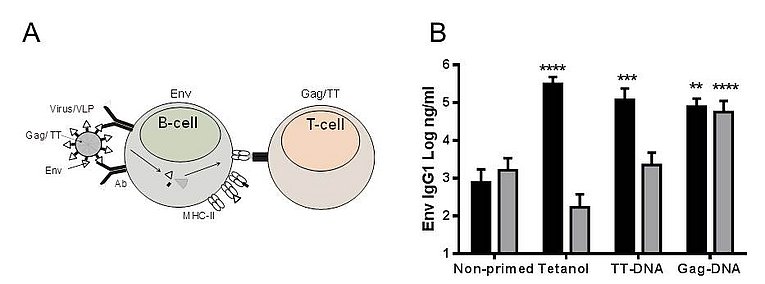Inducing long-lasting HIV Env-specific antibody responses by intrastructural help
Induction of long-lasting antibody responses protecting from HIV infection remains a major challenge in HIV vaccine development. While the Vax003 and the RV144 HIV vaccine trials both induced non-neutralising antibody responses, only the later provided evidence for protection. This difference in efficacy correlated with Env IgG3 subtype responses and Fc-effector functions of Env-specific antibody responses (Chung et al., 2014; Yates et al., 2014). This suggests that non-neutralising antibodies may provide some level of protection by Fc effector functions. Animal models further indicate that the potency of neutralising antibodies may also depend on Fc effector functions (Bournazos et al., 2014; Hessel et al., 2007; Horwitz et al., 2017). Using a simultaneous challenge model in non-human primates, we could demonstrate that non-neutralising antibodies can prevent infection of the very first cells. The natural T helper cell response to HIV Env immunogens seems to be biased in mice and men resulting in a dominant IgG1 subtype response in mice (Storcksdieck et al., 2015). The mouse IgG1 subclass is known to be associated with suboptimal Fc effector functions (Nimmerjahn and Ravetch, 2005; Nimmerjahn et al., 2005; Biburger et al., 2011). We have therefore developed HIV virus-like particle (VLP) vaccines, which allow for modulating the IgG subtype response by intrastructural help (Nabi et al, 2013; Storcksdieck et al., 2015). Since naive Env-specific B-cells can internalize and process entire VLPs in a BCR and Env dependent manner, T helper cells specific for internal viral proteins (e.g. Gag) can provide help for Env-specific B-cells (Fig. 1A). Priming mice with Tetanol prior to booster immunisations with VLPs incorporating a T-helper cell epitope of tetanus toxoid also increased the HIV-Env antibody response (Fig. 1B). This indicates that T helper cells induced by licensed vaccines can be harnessed to optimise the HIV Env antibody response to particulate vaccines (Elsayed et al., 2018).
HIV Env antibody responses induced by various immunisation strategies rapidly decline. In contrast, live-attenuated vaccines, such as the measles vaccine and the varicella zoster virus vaccine induce persisting antibody responses. Therefore, the long-term perspective of the current project is to harness T helper cells induced by such live attenuated vaccines to provide intrastructural help for Env-specific antibody responses. It is postulated that the T helper cells imprint the persistence of the antibody response onto Env-specific B-cells by triggering their differentiation into long-lived plasma cells. The proposed project seeks proof-of-concept for extending the duration of antibody persistence by intrastructural help. Experimentally, mice will be immunised by a measles virus vaccine or mCMV as a model for a persisting live-attenuated vaccine. T helper cell responses to these vaccines will be characterised and immunodominant epitopes identified. The epitopes will be incorporated into VLPs that will be used for boosting mice previously primed by the measles or the mCMV vaccines. HIV Env antibody responses will be characterised 2 weeks, and 3, 6, and 12 months after VLP immunisations for IgG subtype, glycosylation, and Fc-effector function (Lux et al., 2013; Kao et al., 2015; Kao et al., 2017). In addition, the frequency of Env-specific memory B-cells, short-lived plasma blasts, and long-lived plasma cells will be determined.




